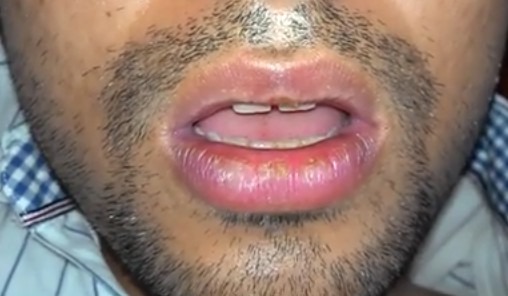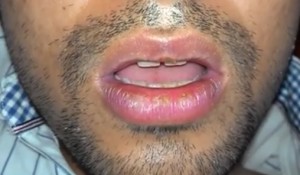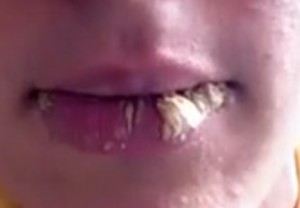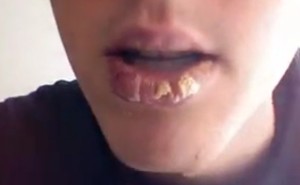Exfoliative cheilitis refers to a chronic skin condition that manifests in form of inflamed lips. This condition is usually characterized by consistent peeling of skin on the lips often showing dryness and flaking. The persistent peeling off of lips eventually exposes raw skin and causes symptoms such as fissure, cracking, and burning or pain. The lips are always chapped and they tend to appear red, inflamed and irritated with a burning sensation. This condition can cause discomforts and soreness.
Although exfoliative cheilitis is uncommon, it is a chronic skin disorder and mainly affects young adults and those below age of 30 years. It mainly develops in the vermilion border— the sharp separation of the red colored part of lip and the adjacent normal skin. Vermilion is that white roll, which forms the border line between the lip and normal surrounding skin.
The constant scaling of lips in people with exfoliative cheilitis often leads to increased sensitivity. It is chronic meaning that the condition tends to reoccur after some episode of remission.
While it is not a serious or life threatening disorder, its onset may signal an underlying condition. It may indicate that there is something wrong in the body. This condition may also indicate deficiency of vitamin or increased amount of toxins in body for example, in liver.
Causes of exfoliative cheilitis
It is not clearly known why exfoliative cheilitis occurs although there are some factors, which have been identified as possible triggers of this condition. One of the factors is factitious damage where a person tends to deliberately produce signs of having an illness. A person with factitious damage can eventually have exfoliative cheilitis often showing symptoms of the onset of this condition including sucking of lip, licking of lip, and mouth breathing.
Another possible trigger of exfoliative cheilitis is thought to be overgrowth of Candida yeast. This is a fungal mouth infection, which is caused by Candida albicans, a fungus that is found in body but in subtle amounts. In most of its time, this yeast remains dormant and it is only when there is a stimulated effect, which makes it to become active and cause an infection.
People with HIV infection also tend to develop exfoliative cheilitis. In people with HIV, they are susceptible to many kinds of skin problems because there is weak immune system that prevents the ability of the body to defend itself against opportunistic infections.
Another possible triggering factor of exfoliative cheilitis is nutritional deficiency. When there is primary or secondary nutritional deficiency, it may cause the keratin to deform leading to this skin condition of the lip. Having poor oral hygiene is also associated with exfoliative cheilitis.
When you do not brush and clean your mouth, you may encourage pathogens like fungi, bacteria and virus to multiply something that results in harming the skin or peeling off of lips. Allergies may also be linked to development of this skin condition although it rarely occurs.
Use of antibiotic therapy has been cited to have an increased propensity of triggering exfoliative cheilitis especially when has been on a long term use of these medicines. Antibiotics, when taken for a long time can result in imbalances of the microbials in body.
People who have compromised or depressed immune system are often likely to have the skin peeling of the lip area. In this case, the keratin in the skin is mistaken for a foreign substance, and the immune system is likely to attack and ward it off leading to inflammation. When the body tried to remove the inflamed tissue, this could result in peeling of lip.
Symptoms of exfoliative cheilitis
The common notable symptoms of exfoliative cheilitis are a lip skin that is constantly peeing off especially on the outer part of lips or the vermilion. The condition may develop in one or both lips. However, it mostly tends to manifest in the lower lip. At first, the skin of the lip may look normal without any visible changes but soon after it starts to thicken on the outer layer of vermilion.
In this condition, the peeling of lip occurs in various areas in such a way that at any one time, there is some part of lip, which is flaking or peeling off. Later on, the peeling exposes the raw skin and in turn, there is a sensation of burning and pain.
A hemorrhagic crust may develop because of bleeding. Flaking and fissuring occurring in the lip makes it appear unsightly and often embarrassing. In addition to these symptoms, a person with exfoliative cheilitis may show other signs like itching, burning sensation, fissuring, and ulceration of lip. There may be tingling or numbness over the lip part that is affected. The lips may also become dry, swollen and discolored.
Patients who have exfoliative cheilitis, because of the unappealing look of their lips, they tend to develop depression, stress, and mood disturbances often trying to avoid social interactions. Discomforts are caused by pain and the burning sensation.
Exfoliative Cheilitis Treatment
Prior to treatment, there is need to isolate this condition from other skin conditions. A long term treatment may be required because it is a chronic disorder. There may be no specific treatment and much of the therapy is aimed at treating the symptoms. The therapy includes oral hygiene, using lip balm to keep lips moist, and taking diet rich in vegetables and fruits. Vitamin supplements may be taken. Medications such as antibiotics, systemic steroid, and antifungal creams may be administered.
Pictures



